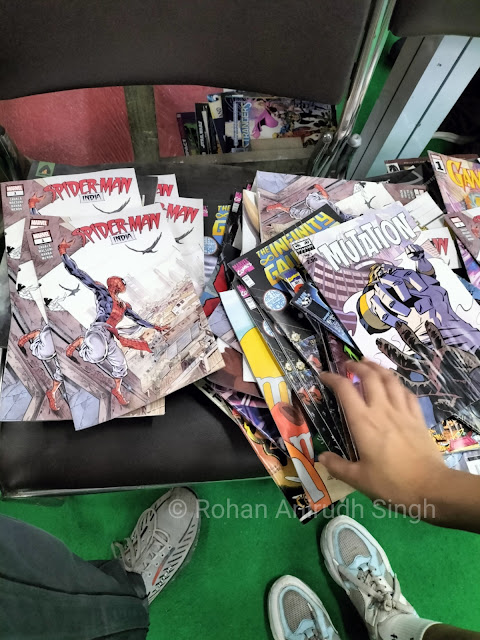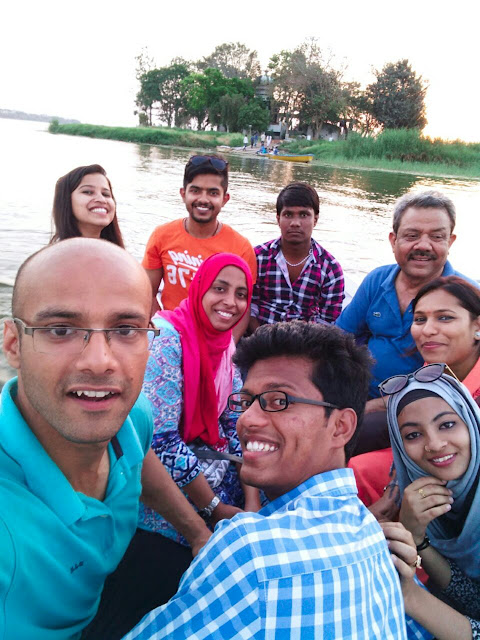Friday, August 16, 2024
Tarikhstan Podcast #3 - Tomb of Muhammad Shah Sayyid
Monday, August 12, 2024
The 28th Delhi Book Fair 2024
Wednesday, November 1, 2023
Mumbai, in November - Via my Camera
I had an opportunity to visit Mumbai in November for Work. So, took some time off to cover some of the important sites of the city, which is the financial capital of India.
Chhatrapati Shivaji Maharaj Terminus -
It is an incredible railway station and the building is palatial. One cannot think about Mumbai and not think about the Chhatrapati Shivaji Maharaj Terminus.
The Gateway of India -
.......
All Pictures © Rohan Anirudh Singh
Monday, October 24, 2022
The Tarikhstan Podcast Episode #2: Satpula Dam aur Diwali.. Ek Kareebi Rishta.. As per Sir Syed's Asar us Sanadid.. (Hindi)
The second Podcast was in video form and covered the Medieval Era dam of Delhi, known as Satpula (Const 14th Century CE). It belonged to the Delhi Sultanate Era. I read from Sir Syed Ahmed Khan's book Asar us Sanadid (Urdu) in which he writes about the Satpula dam, as he saw it, in 1850s CE...
Friday, June 24, 2022
The Tarikhstan Podcast Ep. 1 - Gandhi, Savarkar and Communalism in India (w/ Thanmaya P.)
I did a podcast on my alternate channel and am sharing the link with you. When I am not Traveling to historical monuments I am talking about history. Historian Rohan is my alternate handle. The Historian Rohan Podcast Episode #1. Topic: Mahatma Gandhi, Vir Savarkar and Communalism in India (with Thanmaya Prakash)...
.......
Monday, June 14, 2021
Sketch of a Teacher (Professor Rizwan Qaiser): II
On 6th May 2021 this blogger, along with 2 former batchmates (Mr. Jitendra Singh and Ms. Sabira Fatimi), organized a condolence meet on Zoom in honor of Professor Rizwan Qaiser, for the benefit of MA Batch (2015-17). These are the excerpts of what he spoke in the meet -
‘Sketch of a Teacher’
M S Dhoni once said that he preferred cricketers coming from small towns as they understand the concept of struggle and because they understand the concept of a struggle, they can fight the odds better.
Now while he was saying that for cricketers, I would like to add and say because that individual has seen the struggle, he would not want his children to face the same.
And, that was what Rizwan Sir’s students were, his children.
In an era when some teachers are in the education world to either earn money or have tunnel vision vis a vis their research, Rizwan Sir was one of those teachers who cared for his students while they were in college and cared for them when they were out of it.
In ancient times, the teacher (or the guru) was a father figure. Professor Rizwan Qaiser was one such father figure, a fast reducing class in the contemporary era where some educationists are fast forgetting that concept.
How he would combine his theoretical lectures with real-life examples was incredible. It made sure that we would associate Modern Indian History with our daily lives.
I got my knowledge about Mahatma Gandhi from Rizwan Sir. The Gandhian Concepts of Satyagraha, Ahimsa, Antyodaya were explained and discussed threadbare in the class.
We keep saying that the lamp of Gandhian values has to be kept lit so that the future generations do not forget the philosophy of the Mahatma. That can only be possible if the teachers have a deep understanding of the subject so that they can explain it to future generations in an ‘interesting’ manner. It is essential for the teachers to ‘impress upon the students' that Gandhiji’s vision of Ahimsa, non-violence, and Antyodaya can ‘never’ get outdated.
With the passing of Professor Rizwan, such efforts have been dealt a blow. Yet, we can take solace from the hope that his students will take up the responsibility of explaining Gandhian Principles to future generations and also stand by them. That would ensure that the Gandhian ideology lives on, especially in trying times like now, and in trying times that could come in the future.
May his Soul Rest in Peace.
........
Sunday, June 13, 2021
Sketch of a Teacher (Professor Rizwan Qaiser) : I
Professor Rizwan Qaiser passed away recently. He was a scholar of Modern Indian History. The Pandemic claimed him. He is survived by his wife and son. He will be missed.
--------
This blog (and its writers' tryst with blogging) is over 11 years and counting. This period can be divided into 3 stages. The first stage, when I traveled across India for 4 years and blogged. The second stage, when I decided to take my love for history to the next level and go pro with it (read enter the world of academics). The third (and the current) stage, when I found a balance between my academic life and my blogging life.
Professor Rizwan Qaiser (or Rizwan Sir, as we called him) was an important figure in the second stage of this writer's life (in the world of travel, heritage, and history). I completed my Master's of Arts in History from Jamia Millia Islamia in 2017. During my time over there, he was the Head of the Department. I was lucky and also trussed up, by the fact that many luminary minds were teaching in the department of history (like Professor Azizuddin Husain, Professor R Gopinath, Professor Nishat Manzar, Professor A P Sen, Professor R P Bahuguna, and many more) at that point of time. Many of them were not easy on the kids. But, we knew that Rizwan Sir always had our backs.
I remember one incident clearly. As part of my training in History, I had to learn about European History too. So, in one of the assignments, which I had submitted, my entire batch (apart from one or two kids) was blamed for plagiarism (without checking) by a strict professor (due to the folly of a few). I remember losing my cool over it because as a blogger, I understand the evil of plagiarism and would never partake in it (I empathize with those who stood in front of me that day, as I was in a complaining mode).
We went to Professor Rizwan with our troubles and he intervened in that moment. In the end, the blanket charge of plagiarism was taken back. All this ended on a bittersweet note for me as the strict Professor gave me very good marks, both in the assignment and in the final exam.
My memories of taking a course under Rizwan Sir are quite fond. The course was on Mahatma Gandhi. Rizwan Sir, through his lectures and my discussions with him on the subject, made me understand the Gandhian Concepts of Satyagraha, Antyodaya, etc. I would say it was Rizwan Sir, who explained to me what Mahatma Gandhi stood for.
As a teacher, he was articulate, had a firm grip on the subject, and most importantly, he was adept in breaking down concepts, incidents, and theories to make things understandable for the students.
As our time in Jamia came to an end he, at his own risk, as the Head of the Department (because the university was not forthcoming), lead a trip of us history students, to an excursion and exploration trip to Bhopal, Sanchi, Bhimbetka, Bhojpur, and Udayagiri Caves. It was an incredible learning experience. No amount of lectures can substitute an actual visit to a monument.
Rizwan Sir's care and concern for students extended even after our batch had passed out. He arranged for one of his former students (an academic luminary) to help those who were preparing for the National Eligibility Test. I credit my clearing this test directly to this intervention.
In an era when some teachers are in it just to earn a living, in an era when some teachers have zero connection with history, in an era when some teachers view students as products on a production line (once they leave that line, they are forgotten) Rizwan Sir was one of those teachers who would always have time to sit and give his opinion, to students, or ex-students, whenever they were in a tough situation.
Across the country, he was well known for participating in television and radio debates across multiple forums. In such debates, he was always the voice of reason and logic. Being an ace debater himself, I once recalled him saying, 'these days it's almost as if people have taken steroids before coming to a tv debate!'. For the country, he was a television personality but for his students, he was their teacher.
His teachings on Mahatma Gandhi, Secularism, Maulana Azad, etc will live on through his students.
He will be missed.
May his Soul Rest in Peace.
........
(This is the first article in a two part series. You can click this link to read the second article.)















































